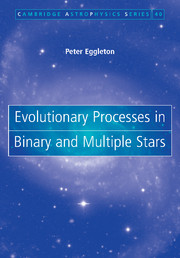Book contents
- Frontmatter
- Contents
- Preface
- 1 Introduction
- 2 Evolution of single stars
- 3 Binary interaction: conservative processes
- 4 Slow non-conservative processes
- 5 Rapid non-conservative processes
- 6 Accretion by the companion
- Appendix A The equations of stellar structure
- Appendix B Distortion and circulation in a non-spherical star
- Appendix C Perturbations to Keplerian orbits
- Appendix D Steady, axisymmetric magnetic winds
- Appendix E Stellar dynamos
- Appendix F Steady, axisymmetric, cool accretion discs
- References
- Subject index
- Stellar objects index
6 - Accretion by the companion
Published online by Cambridge University Press: 17 August 2009
- Frontmatter
- Contents
- Preface
- 1 Introduction
- 2 Evolution of single stars
- 3 Binary interaction: conservative processes
- 4 Slow non-conservative processes
- 5 Rapid non-conservative processes
- 6 Accretion by the companion
- Appendix A The equations of stellar structure
- Appendix B Distortion and circulation in a non-spherical star
- Appendix C Perturbations to Keplerian orbits
- Appendix D Steady, axisymmetric magnetic winds
- Appendix E Stellar dynamos
- Appendix F Steady, axisymmetric, cool accretion discs
- References
- Subject index
- Stellar objects index
Summary
Matter that leaves the surface of one component of a binary can be partly or wholly accreted by the companion. We have seen that the loser could be losing mass either by RLOF or by stellar wind, perhaps binary-enhanced; the accretion process has even more options, and these are modelelled with even less confidence. A major reason why the accretion process can be more complex than the mass-loss process is that gainers can have a very wide range of radii, from black holes and neutron stars (at ∼3–30 km) to white dwarfs (∼104 km) to normal dwarfs (∼0.1–10 Gm), and even occasionally to sub-giants (∼3–30 Gm) or giants (≳10–30 Gm); whereas the loser is usually only in the last three of these categories. Not only does the available energy of the accreted material vary (inversely) over the same range, but also different physical forces (magnetic, viscous, rotational, gravitational) may dominate at different radii from the gainer.
The study of accretion is one of the most active areas in stellar astrophysics. Phenomena, often dramatic, are observed to happen on timescales ranging upwards from milliseconds. This book will not attempt to cover the ground in detail – partly for lack of space, but also because this book is intended to concentrate on the long-term evolution of binaries rather than on their short-term behaviour. For a fuller treatment the reader is referred to some standard works: Lewin and van den Heuvel (1983), Frank et al. (2002).
- Type
- Chapter
- Information
- Evolutionary Processes in Binary and Multiple Stars , pp. 231 - 256Publisher: Cambridge University PressPrint publication year: 2006



